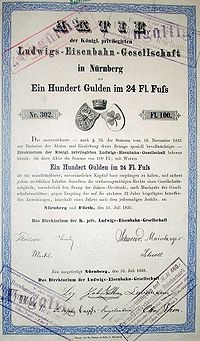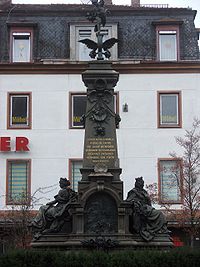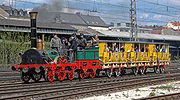
Bavarian Ludwigsbahn
Encyclopedia



Nuremberg
Nuremberg[p] is a city in the German state of Bavaria, in the administrative region of Middle Franconia. Situated on the Pegnitz river and the Rhine–Main–Danube Canal, it is located about north of Munich and is Franconia's largest city. The population is 505,664...
to Fürth
Fürth
The city of Fürth is located in northern Bavaria, Germany in the administrative region of Middle Franconia. It is now contiguous with the larger city of Nuremberg, the centres of the two cities being only 7 km apart....
in the state
States of Germany
Germany is made up of sixteen which are partly sovereign constituent states of the Federal Republic of Germany. Land literally translates as "country", and constitutionally speaking, they are constituent countries...
of Bavaria
Kingdom of Bavaria
The Kingdom of Bavaria was a German state that existed from 1806 to 1918. The Bavarian Elector Maximilian IV Joseph of the House of Wittelsbach became the first King of Bavaria in 1806 as Maximilian I Joseph. The monarchy would remain held by the Wittelsbachs until the kingdom's dissolution in 1918...
on 19 February 1834.
Background
The first reports from England over the planning of railways attracted great attention in Germany, particularly in Bavaria, where the road between the important commercial cities of Nuremberg and Fürth was the busiest road connection in the kingdom. Bavarian interest was also stimulated by Friedrich ListFriedrich List
Georg Friedrich List was a leading 19th century German economist who developed the "National System" or what some would call today the National System of Innovation...
’s advocacy of an all-German railway system and the reports of Joseph von Baader, whom King Ludwig
Ludwig I of Bavaria
Ludwig I was a German king of Bavaria from 1825 until the 1848 revolutions in the German states.-Crown prince:...
had sent to England
England
England is a country that is part of the United Kingdom. It shares land borders with Scotland to the north and Wales to the west; the Irish Sea is to the north west, the Celtic Sea to the south west, with the North Sea to the east and the English Channel to the south separating it from continental...
to study railways. After a discussion of this topic in the first Bavarian parliament in 1825, it authorised the king to build an experimental railway in the Nymphenburg Palace park
Nymphenburg Palace
The Nymphenburg Palace , i.e. "Nymph's Castle", is a Baroque palace in Munich, Bavaria, southern Germany. The palace was the main summer residence of the rulers of Bavaria.-History:...
. As the king’s 1828 request for Franconian merchants to begin building a railway line led to no action, he turned his attention to his favourite project, the building of a canal between the Danube
Danube
The Danube is a river in the Central Europe and the Europe's second longest river after the Volga. It is classified as an international waterway....
and the Main.
Establishment
After railways had been operating in England for a few years, local businesspeople decided to build a railway line along the Nürnberg-Fürth road. In 14 May 1833 they founded the Gesellschaft zur Errichtung einer Eisenbahn mit Dampffahrt zwischen Nürnberg und Fürth ("company for the establishment of a steam railway between Nuremberg and Fürth") to develop the railway. Within six months the two main instigators from Nuremberg, the merchant and market chief, George Zacharias Platner, and the head of the poly-technical school, Johannes Scharrer, had successfully raised the planned share capital of 132,000 guildersSouth German gulden
The Gulden was the currency of the states of southern Germany between 1754 and 1873. These states included Bavaria, Baden, Württemberg, Frankfurt and Hohenzollern....
. The proposed dividend of 12 2/3% was met with skepticism, although the company did, in fact, pay a dividend of 20% in 1836.
King Ludwig was an unenthusiastic supporter of railways because of his preference for building the Ludwig Canal
Ludwig Canal
The Ludwig Canal, also known as the Ludwig-Donau-Main-Kanal or Ludwigskanal, is an abandoned canal in Germany. It linked the Danube River at Kelheim with the Main River at Bamberg, thus connecting the Danube basin with the Rhine basin...
between the Main and the Danube
Danube
The Danube is a river in the Central Europe and the Europe's second longest river after the Volga. It is classified as an international waterway....
; this was actually built between 1836 and 1846. The canal was relatively unsuccessful because of its profusion of locks, its narrowness and early competition from railways, but it foreshadowed the more successful Rhine-Main-Danube Canal
Rhine-Main-Danube Canal
The Rhine–Main–Danube Canal , located in Bavaria, Germany, connects the Main and the Danube rivers across the European Watershed, running from Bamberg via Nuremberg to Kelheim...
built on a similar route and completed in 1992. Ludwig allowed the railway company to use his name and authorized his government to buy a token two shares in it. Significantly for the construction of the railway, the king made available the Bavarian road builder, Paul Camille von Denis
Paul Camille von Denis
Paul Camille Denis, later von Denis, was an engineer, railway pioneer and participant in the Hambach Festival, the German political protest of 1832....
, for the railway construction. Von Denis adopted the English rail gauge
Rail gauge
Track gauge or rail gauge is the distance between the inner sides of the heads of the two load bearing rails that make up a single railway line. Sixty percent of the world's railways use a standard gauge of . Wider gauges are called broad gauge; smaller gauges, narrow gauge. Break-of-gauge refers...
of 1435 mm
Standard gauge
The standard gauge is a widely-used track gauge . Approximately 60% of the world's existing railway lines are built to this gauge...
for the nearly dead-straight 6.04 km-long single-track line next to the Fürth-Nuremberg road.
Start of services
In 7 December 1835 the company opened the first German steam-powered railway line for passenger and freight traffic before a large public gathering. The steam locomotiveSteam locomotive
A steam locomotive is a railway locomotive that produces its power through a steam engine. These locomotives are fueled by burning some combustible material, usually coal, wood or oil, to produce steam in a boiler, which drives the steam engine...
Adler
Adler (locomotive)
The Adler was the first locomotive which was successfully commercially used for rail transport of passengers and goods in Germany. The rail vehicle was constructed and built in 1835 from the british railway pioneers George and Robert Stephenson in the english town Newcastle...
("eagle") had been supplied with its driver by Stephenson
George Stephenson
George Stephenson was an English civil engineer and mechanical engineer who built the first public railway line in the world to use steam locomotives...
’s company from Newcastle
Newcastle upon Tyne
Newcastle upon Tyne is a city and metropolitan borough of Tyne and Wear, in North East England. Historically a part of Northumberland, it is situated on the north bank of the River Tyne...
. The Remy & Co aus Rasselstein company of Neuwied
Neuwied
Neuwied is a town in the north of the German state of Rhineland-Palatinate, capital of the District of Neuwied. Neuwied lies on the right bank of the Rhine, 12 km northwest of Koblenz, on the railway from Frankfurt am Main to Cologne...
, supplied only the 15 feet (4.6 m)-long rails of rolled wrought iron. The carriages were suppled by local wagon-builders.
Already on 20 September 1831 the private narrow gauge, horse-drawn
Wagonway
Wagonways consisted of the horses, equipment and tracks used for hauling wagons, which preceded steam powered railways. The terms "plateway", "tramway" and in someplaces, "dramway" are also found.- Early developments :...
Prince William Railway coal railway had opened between Hinsbeck (Ruhr) and Nierenhof, but it did not excite the public attention of a steam-hauled and passenger railway. Nevertheless, King Ludwig did not visit the railway named after him until August 1836. The cost of building the railway, which had been estimated at 132,000 guilders, actually reached 170,000 guilders as a result of lack of railway building experience and, in particular, the high price of land acquisition in the absence of a law providing for compulsory purchase
Eminent domain
Eminent domain , compulsory purchase , resumption/compulsory acquisition , or expropriation is an action of the state to seize a citizen's private property, expropriate property, or seize a citizen's rights in property with due monetary compensation, but without the owner's consent...
.
Operations
Beginning on 8 December 1835 a horse-drawn services operated on the line from Nuremberg to Fürth once an hour. The Adler only operated at 13:00 and 14:00 daily. The high cost of importing hard coal from SaxonyKingdom of Saxony
The Kingdom of Saxony , lasting between 1806 and 1918, was an independent member of a number of historical confederacies in Napoleonic through post-Napoleonic Germany. From 1871 it was part of the German Empire. It became a Free state in the era of Weimar Republic in 1918 after the end of World War...
, which in the beginning still had to be brought by horse cart, prevented in the early years regular use of the Adler or the Pfeil ("arrow"). With the acquisition of more locomotives, only the early and late services were horses-drawn. Finally in 1863 horse operations were abandoned to reduce maintenance costs (especially the provision of horse tracks) and to raise speeds.
Goods traffic at first consisted of the carriage of newspapers and beer. General freight traffic only started in 1839 and mail traffic in 1840. The success of the line is shown by the fact that up to 1855 dividends were never less than 12%. At the time this was considered a magnificent capital return. Nevertheless, the government refused permission to extend the line to Würzburg
Würzburg
Würzburg is a city in the region of Franconia which lies in the northern tip of Bavaria, Germany. Located at the Main River, it is the capital of the Regierungsbezirk Lower Franconia. The regional dialect is Franconian....
.
Closure
Competition developed with the building of horse tramsHorsecar
A horsecar or horse-drawn tram is an animal-powered streetcar or tram.These early forms of public transport developed out of industrial haulage routes that had long been in existence, and from the omnibus routes that first ran on public streets in the 1820s, using the newly improved iron or steel...
between Nuremberg and Fürth, particularly once they were electrified in 1898. From 1893, part of the line was double-tracked but this was never completed. Traffic and profits fell constantly.
The Ludwigsbahn closed on 31 October 1922. The old station building in Fürth was torn down in 1938, to make room for a Nazi Party
National Socialist German Workers Party
The National Socialist German Workers' Party , commonly known in English as the Nazi Party, was a political party in Germany between 1920 and 1945. Its predecessor, the German Workers' Party , existed from 1919 to 1920...
parade ground, now a plaza called Fürther Freiheit ("Furth Liberty"). The Nuremberg station was demolished in 1952 to allow the construction of a new multistory building. The line was leased to the Nuremberg tramways and trams operated on it until 1981. It was proposed to develop it as a high-speed tramway between Nürnberg and Fürth, but this was only achieved in the 1970s and 1980s with the construction of part of line U1 of the Nuremberg U-Bahn
Nuremberg U-Bahn
The Nuremberg U-Bahn is a metro run by VAG Nürnberg , which itself is a member of the VGN . The Nuremberg U-Bahn is Germany's newest metro...
along the route, partly underground and partly elevated. This was opened to Fürth station
Fürth Hauptbahnhof
Fürth Hauptbahnhof is the central railway hub for the city of Fürth in Bavaria, Germany. The station is mainly frequented by regional services...
on 5 December 1985, 150 years after the opening of the original line.
The line ran from the Nuremberg station in Plärrer place, along today's Fürther Straße, past the boundary with Fürth and then followed the present Hornschuchpromenade to the Ludwig station at Fürther Freiheit, 100 m north of Fürth station.
Locomotives and carriages
The Ludwigsbahn possessed many locomotives during its 87 years of operation. Some were bought second-hand, many were sold when it was closed.| Name | Design | Manufacturer | Acquired | Disposed |
|---|---|---|---|---|
| Adler | 1A1 | Stephenson 1835 | 1835 | sold 1857 |
| Pfeil | 1A1 | Stephenson 1836 | 1836 | sold |
| Nürnberg-Fürth | 1A1 | Henschel Henschel & Son Henschel & Son was a German company, situated in Kassel, best known during the 20th century as a maker of transportation equipment, including locomotives, trucks, buses and trolleybuses, and armoured fighting vehicles and weapons.... 1852/14 |
1852 | scrapped 1889 |
| Phoenix | 1A1 | Maffei 1853/127 | 1853 | scrapped 1869 |
| Adler II | 1A1 | Maffei 1857/279 | 1857 | scrapped 1889 |
| Johannes Scharrer | 1A1 | Henschel 1865/108 | 1865 | scrapped 1887 |
| Faust | 1A1 | Maffei 1845/6 | 1872 | scrapped 1881 |
| Henlein | 1A1 | Maffei 1845/8 | 1873 | scrapped 1880 |
| Wallenstein | 1A1 | Kessler 1845/30 | 1875 | scrapped 1885 |
| Bavaria | Bn2t | Maffei 1879/1204 | 1879 | sold 1923 |
| Pegnitz | Bn2t | Maffei 1880/1224 | 1880 | sold 1923 |
| Franconia | Bn2t | Maffei 1881/1248 | 1881 | sold 1923 |
| Daniel Ley | 1Bn2t | Maffei 1886/1414 | 1886 | sold 1923 |
| Johannes Scharrer II | Bn2t | Maffei 1887/1453 | 1887 | sold 1923 |
| Nürnberg-Fürth II | Bn2t | Maffei 1889/1538 | 1889 | sold 1923 |
| Germania | 1Bn2t | Maffei 1906/2511 | 1906 | sold 1923 |
| Ludwig | 1Bn2t | Maffei 1906/2549 | 1906 | sold 1923 |
In 1935 a replica of the Adler was constructed on old plans for the 100-year anniversary of the German railways, but it was seriously damaged on 17 October 2005 together with many other preserved locomotives in the great fire at the Nuremberg shed. However it was painstakingly restored in 2007 at a cost of € 1M and made operational again. The greatest number of carriages during the line’s existence was in 1893: 44 coaches, 1 luggage van and 10 wagons.
Sources
- Klee, Wolfgang, Bayerische Eisenbahngeschichte, Part 1: 1835-1875 in Bayern-Report, Fürstenfeldbruck, 1993.
- Wolff, Gerd, Deutsche Klein- und Privatbahnen, Part 6, Bayern, Gifhorn, 1978.
- Deutsche Reichsbahn, Die Deutschen Eisenbahnen in ihrer Entwicklung 1835-1935, Berlin, 1935.
- DB Museum, Geschichte der Eisenbahn in Deutschland, Volume 1: Ein Jahrhundert unter Dampf, Die Eisenbahn in Deutschland 1835 – 1919, Nürnberg, 2005
See also
- Royal Bavarian State RailwaysRoyal Bavarian State RailwaysAs a nation-state, Germany did not come into being until the creation of the German Empire in 1871 from the various German-speaking states such as Prussia, Bavaria, Saxony, Baden and Württemberg. By then each of the major states had formed its own state railway and these continued to remain...
- List of Bavarian locomotives and railbuses

